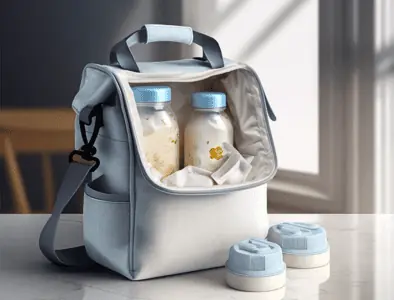Knowing how to effectively burp a baby is your first line of defense against gas pains and fussiness.
Handling a fragile infant can feel intimidating at first. You need to support their wobbly head while finding the right spot to pat. Don’t worry, we have plenty of experience in this department. Here is some medical guidance and practical tips to help you master the art of the burp.
Key Takeaways
- Burping releases swallowed air to prevent discomfort, gas pains, and a false sense of fullness.
- The four main positions are over the shoulder, face down on your lap, sitting up, and the walking hold.
- Bottle-fed babies generally require more frequent burping than breastfed babies due to faster milk flow.
- If your baby doesn’t burp after 10 to 15 minutes of trying, it is usually safe to stop if they seem content.
Tips for Successful Burping
Before you start patting away, here are a few pro tips to make the process smoother for both of you.
- Protect your clothes: Burping often leads to spit-ups. Always keep a burp cloth between you and your baby to save your outfit. It is also smart to keep a backup cloth nearby for larger messes.
- Target the left side: When patting, focus slightly to the left of your baby’s spine. The stomach is curved toward the left side of the body, so this placement helps move the air bubble up and out.
- Adjust your pressure: Every baby is different. Some release gas with a gentle rub, while others need a slightly firmer, rhythmic pat. Cup your hand to make the patting gentler on their back.
How to Burp a Baby: Four Ways
On Your Chest or Shoulder
This is one of two positions I recommend to parents for more effective burping. The outer stomach muscles are more relaxed than they would be in a sitting position. This allows more air to be expelled from the stomach (1).
Editor's Note:
Dr. Leah Alexander, MD, FAAPThis is the classic method most parents learn in the hospital. It is straightforward, but you must be mindful of head support with newborns.
1. Place Your Cloth
Drape a burp cloth over your shoulder. Make sure it extends far enough down your back to catch any projectile spit-up.
2. Place Baby
Hold your baby against your chest so their chin rests on your shoulder. If your baby is still very small, you can place them lower on your chest. Just ensure you support their head and neck with one hand.
3. Release the Burp
Support your baby’s bottom with one hand. Use your other hand to gently pat or rub their back between the shoulder blades.
Over 6 Months
Face Down on Lap
This is the second position I find most effective. Once again, the outer belly muscles are relaxed, and more air is released. You can turn your baby’s head to the side so that it rests against your lap.Because your baby may spit up a bit more during a burp in this position, you may need an extra cloth. There is no need to worry about the amount of milk that comes up. It is a lot less than it seems and typically does not result in poor weight gain.
Editor's Note:
Dr. Leah Alexander, MD, FAAP1. Prep the Area
Lay a burp cloth across your lap. Position it so it covers your leg and perhaps hangs over the side slightly in case gravity takes over.
2. Position Your Baby
Lay your baby perpendicularly across your lap, belly down.
Use one hand to support their chin and jaw (not the throat) to keep their head slightly elevated. Ensure their head is turned to the side so they can breathe easily.
If your infant is older, you can position them further out on your knees to apply slight pressure to the tummy.
3. Pat Their Back
Use your free hand to firmly rub or pat their back until you hear that relief.
The Walking Hold
Once your baby has better head control, you can try burping while moving. This combines gravity with the soothing motion of walking.
Carry your baby facing out, with their back resting against your stomach. Place one arm under their bottom to support their weight. Place your other arm across their tummy.
The arm across the stomach applies gentle pressure to the gut. Walk around the room with a little bounce or sway. The movement and pressure often dislodge stubborn air bubbles.
Sitting on Your Lap
1. Prep with a Bib
Since your baby will be upright, a bib is usually more effective than a cloth on your leg. Place a cloth over your chest as well just in case.
2. Sit Your Baby Up
Sit your baby on your lap, facing sideways. Support their chest with the heel of your hand. Use your fingers to gently support their chin and jawbones. Be very careful not to put any pressure on the throat area.
3. Lean and Pat
Lean your baby slightly forward. This posture compresses the tummy slightly. Use your free hand to pat their back.
Clinically, I find this position to be the least effective for producing a good burp. Surprisingly, it is a favorite of the nurses who care for newborns in the nursery. Because the baby’s belly is “crunched” in this sitting position, there is a lot of pressure internally on the stomach and intestines.While some air may be released, much of it stays in the stomach, resulting in a cranky, fussy baby hours later. Every infant is different, but many parents in my practice who try this position complain of difficulty burping their baby.
Editor's Note:
Dr. Leah Alexander, MD, FAAPHow to Burp a Sleeping Baby
Babies frequently drift off while eating. The rhythmic sucking motion and a full belly are natural sleep inducers. Whether you are breastfeeding or bottle-feeding, this is common, especially during night feeds.
However, a sleeping baby still has swallowed air. If you lay them down without burping, they may wake up in pain 20 minutes later. The goal is to burp them without fully waking them up.
Avoid positions that require significant movement, like the sitting-up method.
The best position for a sleeping baby is the shoulder hold. Place them gently on your chest; the contact with your heartbeat keeps them soothed. Rub their back in slow circles rather than patting. If that fails, try the face-down lap method, but move slowly when transferring them back to the crib.
Why Burping Is Important
Burping is a non-negotiable part of early parenthood. Unlike adults, babies cannot easily relieve gas on their own. Their abdominal muscles are weak, and they need mechanical help to move gas bubbles up and out (2).
Babies swallow air when they cry, suck on a pacifier, and gulp milk. This air gets trapped in the stomach. These bubbles cause a sensation of fullness. Your baby might stop eating because they feel full, even if they haven’t finished their meal.
If the air moves into the intestines, it causes painful gas. A baby who is hungry but uncomfortable will quickly become fussy. Burping clears space in the tummy so they can finish feeding and sleep soundly.
How Often Should You Burp a Baby?
The frequency depends on your feeding method and your baby’s unique digestion.
For Breastfed Babies:
Burp your baby before switching breasts. This clears room for the second half of the meal. If your baby unlatches and seems squirmy, try a burp then.
For Bottle-Fed Babies:
Bottle-fed infants usually ingest more air. Try to burp them halfway through the bottle or for every 2 to 3 ounces they consume.
If your baby is prone to spit-up or seems very gassy, you may need to pause and burp them more frequently. Formula-fed babies often tend to be gassier, possibly due to the ingredients or the bottle nipple flow (3).
How Long Does Burping Take?
A typical burping session takes about one to two minutes. Sometimes, you get a loud belch immediately. Other times, it requires patience and a change of position.
If you have been trying for 10 to 15 minutes and nothing happens, let it go. Not every feed results in a burp. As long as your baby isn’t squirming or crying, it is safe to lay them down.
However, if your baby arches their back, cries during feeds, or spits up large amounts comfortably, consult your pediatrician. These could be signs of reflux (GERD). This is different from “happy spitting” and requires medical advice (4).
What If Your Baby Doesn’t Burp?
Do not panic if you don’t hear a burp. Some babies are efficient eaters and don’t swallow much air. Others pass the gas out the other end later.
If your baby has colic, you might stress over every trapped bubble. However, studies suggest that aggressive burping doesn’t necessarily cure colic (5). If your baby is inconsolable, speak to your doctor about gas drops or gripe water.
Remember that colic usually peaks at 6 weeks and resolves by 3 to 4 months (6).










